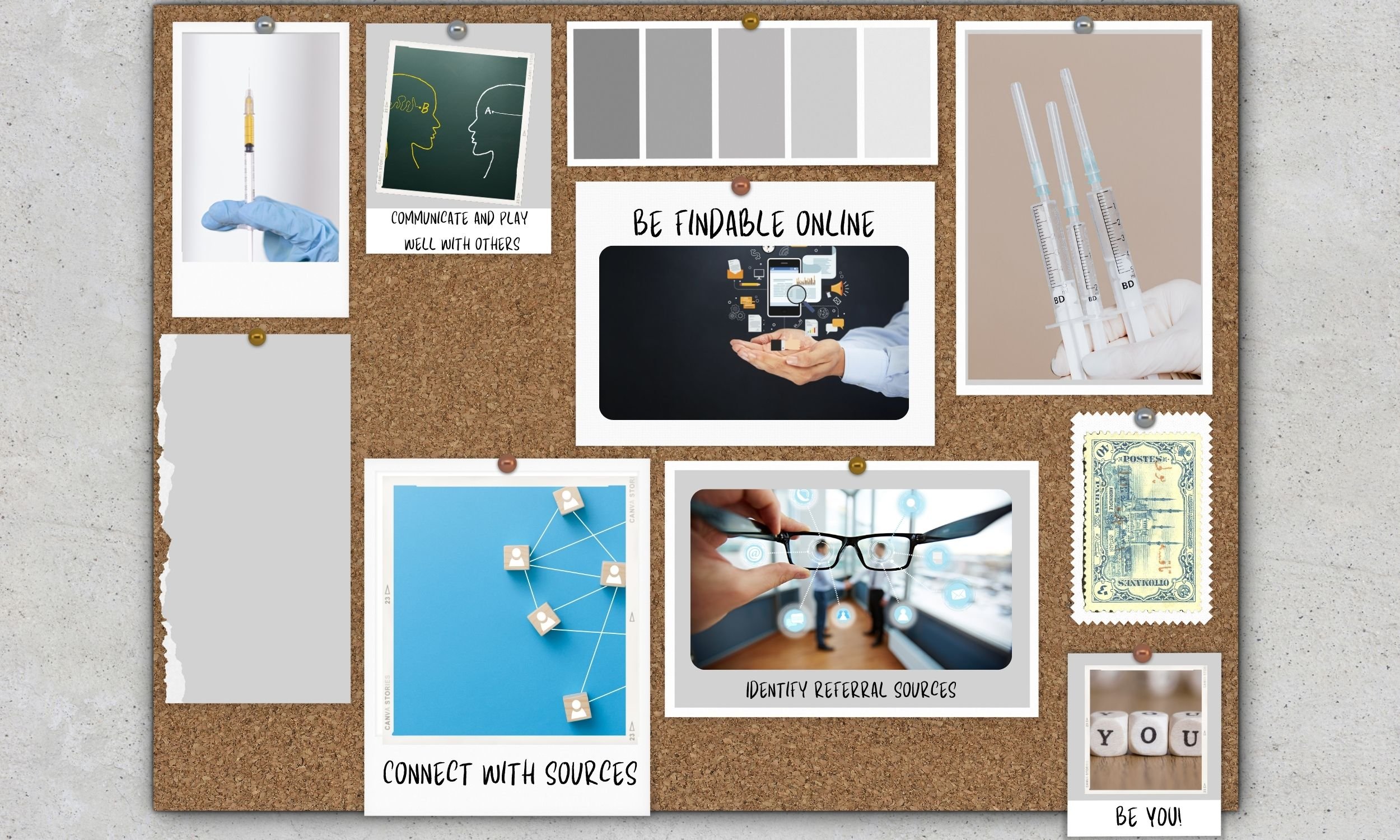Maximizing Your Network: Building Referral Relationships for Your Ketamine Clinic
In this blog, discover five key steps to build and maximize referral relationships for your ketamine clinic. We’ll also share with you some actionable tips on identifying and connecting with potential referral sources. Plus, get insights on establishing a strong online presence and maintaining sustainable relationships so you’ll be set to create your network.
You know the old adage, “it isn’t what you know but who you know.” Well, remember it goes the other way too. You need people to know who you are to refer to you. Which means connecting and getting to know the individuals in your medical community is crucial for the growth and success of your clinic.
So, in this blog we're going to walk you through five key steps to building and maximizing your referral network. Because at the end of the day, we’re here to help people transform their lives with ketamine infusions. But if they don’t know you exist or their doctors don’t know you…then you might as well not exist! Harsh, we know, but it's true!
When it comes to finding and maintaining relationships within your professional network, it’s important to be you and attract the people who reflect your values and what you believe in.
Step 1: Be Clear On Who You Are
Networking and maintaining relationships within your professional network is a lot of work. Think about how much work it takes to maintain happy and healthy relationships with friends and family. It's no different in the professional setting. To make and keep these genuine connections in the business world, simply be you.
Not all potential referring sources are going to completely mesh with you, and that's okay. It's fine not being everybody's cup of tea. Fulfilling networking requires effort that can take you outside of your comfort zone. But it is also essential you be the amazing person that you are.
When it comes to marketing your clinic and getting patients, it’s easy to focus on what you see outside your business. You may want to copy what your competition is doing or follow what’s trending. It can be so easy to get caught up in the hustle of getting more patients and referrals.
But we encourage you to take a step back and be clear about you and your why. Be clear on your purpose and ask yourself the questions that truly matter:
Why do you want to start a ketamine clinic?
Who are you and what is your mission?
Why care about your "why"?
Knowing the answer to these questions gives you the focus and fuel to get through the challenges you will face. But more importantly it forces you to get clear on who YOU are.
Being you makes for sustainable and authentic marketing because it’ll help you cut through the noise. Yes, you can hire someone to help you with the latest app or social media trend to become popular. But what are they going to show? Who are they going to promote? It needs to be you, the authentic you. Have you ever ordered something online, and when you finally got it it was nothing like the pictures or reviews? Yup! Same goes for marketing you and your clinic. Pretending to be someone you aren’t is like being disappointed after opening that Amazon box. Don’t be that, be you.
Step 1 Bottom line: Be true to yourself, define your purpose, and build relationships based on authenticity.
Nowadays, building an online presence is essential in making people know about you.
Step 2: Establish Your Online Presence
Can the people you reach out to and medical contacts find you? Will they have to rely only on a business card you passed out or a letter you sent them? Well, the fact that you are reading this means that you are serious about growing your online presence. You are a modern healthcare professional so what we’ll be sharing may be us preaching to the choir.
You need to be findable online. This is true especially when you are building your ketamine practice, but also as you are building your reputation as a ketamine specialist. Take time to make sure you have at least the following: 1) Have or updated a professional social media profile such as LinkedIn and/or Doximity, and 2) a website for your ketamine clinic.
For bonus points, claim your Yelp page, Google Business Profile, and have an active social media presence. But most likely, you will be busy juggling a lot as you start out. For some, you have no desire nor budget to do these extra things starting out. All good. Aim for good enough, not perfect. Get the website up. Update your professional profiles. And once those are complete, you're good to go for now. Save those extras for later.
Your online presence is where you get to demonstrate who you are and why you are opening a ketamine clinic (remember what we said in Step 1?). It is where you show medical pedigree (degrees, training, etc.) that show you are equipped to perform ketamine therapy. Your website is how you show what makes you special, unique, and worthwhile to refer patients to.
Step 2 Bottom line: Before you start networking, make sure you have a place online for other professionals and referral sources to find you! Update your professional profiles and get your website up!
One of your most reliable sources for patients are referrals, so be sure to cultivate strong referral relationships.
Step 3: Identifying Key Ketamine Patient Referral Sources
Your classic referral sources are: psychiatrists and pain management specialists. Sometimes you can get a referral from a primary care provider who deals with a lot of mental health or pain disorders. For us, our first patients found us online instead of being referred by their doctor. But that was back in 2018. The world was a little less knowledgeable about psychedelic medicines and less open to alternative therapies (although the medical community still has a very long way to go).
Patients are knowledgeable in regards to their alternative options from mainstream medicine. They may seek advice or guidance from outside the classic allopathic medicine paradigm. You may want to consider building relationships with naturopathic doctors, acupuncturists, and other alternative health practitioners.
Another way to go about finding referral sources is to ask your current patients how they found you. Some may mention doctors or businesses you have never even thought of. Others may mention they found you on the internet, i.e. they Googled “ketamine clinic” and found you. Whatever they answer, this is key information to expand your network or confirm that your online presence is strong!
Step 3 Bottom line: Identify potential referral sources, including traditional and alternative healthcare providers. Remember to ask your patients how they found you.
Finding potential referral sources means going out of your way to find these connections within your network.
Step 4: Connect With Potential Referral Sources
Now for the fun part, time to connect with the sources you have identified. Here is a list of things you can do:
Email or mail out an introductory letter
Host a meet-and-greet, in person or virtually
Give a presentation to your local medical society or groups interested in ketamine or psychedelic medicines
We’ve done all or some version of the above since we opened in 2018. There are many other ways you can reach out, and we encourage you to discover which ways of connecting will work best for you. Connecting with other doctors can be a challenge, especially if they are not onboard with ketamine therapy. Others have no clue about it, which can provide an opportunity to educate your fellow colleagues.
There are some biases amongst the different medical specialties with some specialties believing that other specialities shouldn’t be providing ketamine infusion therapy. We’ve heard things like “You’re not a psychiatrist so you shouldn’t treat depression patients.” While we understand the “stay in your lane” sentiment, we aren’t here to replace mental health professionals. We are ketamine specialists. We are here to assist in the care of patients with pain and mood disorders by providing ketamine infusion services.
Step 4 Bottom line: Introduce yourself whether that’s in-person or virtually (ideally both). Find what works best for you, and just do it! Anticipate educating your sources about ketamine.
When it comes to maintaining good referral relationships, it’s important to observe positive cooperation and communication.
Step 5: Build and Maintain Strong Referral Relationships
Healthcare providers can be territorial. Turf wars are all too common in the medical field, and ketamine infusion therapy is no exception. The key to building and maintaining strong relationships with our referring providers is working collaboratively.
Sure, you can try to be the one stop shop for diagnosis, treating, and follow up. But that can limit who would be willing to refer to you. The idea (which is nothing new here!) is to have a cordial working relationship. This is especially true with your fellow licensed healthcare providers, i.e. other doctors and therapists. The last thing you want to do is have a reputation of poaching patients. So don’t, instead work with your referral source, not against.
Not only do you need to, as we say to our daughter, “play nice and share,” you also need to communicate. Update your referral sources, send them a quick thank you note, ask them how you can help them. Communicate and appreciate! Not only is this helpful for your business relationship with them, it is good for patient care.
Step 5 Bottom line: Maintain strong relationships with referral sources through collaboration and communication.
Building strong relationships for your ketamine clinic doesn’t just take hard work, but patience as well.
Maximizing Your Ketamine Clinic's Referral Network: Building and Strengthening Relationships
After reading this blog, we believe we don’t have to sell you on the wisdom of the old adage, “It’s now what you know, but WHO you know” anymore. You’re already onboard because you’re reading this! But also, since you’re reading this blog, this also indicates you are looking for some guidance. All that we shared sounds like a lot, right? We completely understand as we’ve been there too. But let's keep it simple:
Be YOU!
Be findable online
Identify referral sources
Connect with sources
Communicate and play well with others
Our final parting words are this: if we could do it, so can you. And if we could be so bold to give you further advice, be patient and always put patients first. Trust that you are on the right path for you. Whatever challenge you may face as you network and build relationships, these challenges are here for you and your growth. Cheers to you and best wishes!
Are you ready to start your ketamine clinic and begin networking? Join our email list and be notified about the next free webinar and open registration for Ketamine StartUp.
Related Questions:
How can I create a strong online presence that attracts referral sources?
Do as we outlined in Steps 1 and 2 above. Be clear on your why and purpose. This will help in the creation of an authentic and unique branding. Update your professional profile on platforms like LinkedIn and Doximity. Include, where applicable, your ketamine clinic’s logo and website. Your referral sources may check how accessible you are to patients, so claim your Yelp page and Google Business Profile if not already done. Having thoughtful, eye-catching branding (design, color, etc.) across all online platforms is expected!
What are some effective strategies for maintaining relationships with referring providers?
Echoing the above blog, some effective strategies for maintaining relationships with referring providers include working with a team approach (i.e. collaboratively), avoiding turf wars, and fostering a cordial working relationship. We can’t stress enough the importance of regular communication by updating referral sources. Even consider sending thank-you notes, and asking how you can help them. Showing you are appreciative of them and being easy to communicate with go a long way.
If you enjoyed this blog, check out these blogs as well:
Why You Should Market Your Ketamine Clinic On Social Media
Social media can be a powerful tool to launch your ketamine clinic forward. Does this mean that you should also market your ketamine clinic on social media? Read our blog post to find out why you should!
Attracting Ketamine Infusion Patients: Mistakes To Avoid
As physicians-turned-business owners, the world of marketing was extremely new to us. Along the way, we’ve made mistakes and we’ve learned. In this blog, we share some useful tips that have allowed us to attract the right patients to our clinic.
3 Ketamine Infusion Marketing Mistakes To Avoid
Are you sabotaging your ketamine clinic by making some major marketing mistakes? Learn from the marketing mistakes that we’ve made or have seen others make in our blog!











Whether you're curious about ketamine therapy, building your first clinic, or optimizing an established practice, this comprehensive guide has you covered. Featuring 12 essential blog posts organized into three key pillars: Clinical Foundation (ketamine science, protocols, patient selection), Business Operations (best practices, common failures, transition timing), and Marketing & Growth (content strategy, email marketing, sustainable systems).